 W
WThe Adriatic campaign of 1807–1814 was a struggle for supremacy in the Adriatic Sea between the French Navy and the British Royal Navy during the Napoleonic Wars. The early stages of the campaign saw extensive activity between rival frigate squadrons, climaxing at the Battle of Lissa in 1811 at which the last major French force was destroyed and its commander killed. The subsequent campaign was characterised by sustained raids by British warships on French and Italian convoys, warships and coastal positions across the Adriatic, culminating in the capture of several key French port cities in 1813, during the War of the Sixth Coalition.
 W
WThe Adriatic campaign was a minor theatre of war during the Napoleonic Wars in which a succession of small British Royal Navy and Austrian Navy squadrons and independent cruisers harried the combined naval forces of the First French Empire, the Kingdom of Italy, the Illyrian Provinces and the Kingdom of Naples between 1807 and 1814 in the Adriatic Sea. Italy, Naples and Illyria were all controlled either directly or via proxy by the French Emperor Napoleon I, who had seized them at the Treaty of Pressburg in the aftermath of the War of the Third Coalition.
 W
WThe Battle of Allenstein, also known as the Battle of Inkowo was a military engagement during the early stages of the 1807 Fourth Coalition Napoleonic campaign in Poland. While the battle resulted in a French field victory and allowed for a successful pursuit of the Russian army, it failed to produce the decisive engagement that Napoleon was seeking.
 W
WDuring the Napoleonic Wars, the Anglo-Russian War was the phase of hostilities between Great Britain and Russia after the latter signed the Treaty of Tilsit that ended its war with France. Anglo-Russian hostilities were limited primarily to minor naval actions in the Baltic Sea and Barents Sea.
 W
WThe naval Battle of Athos took place from the 19 to 22 June 1807 and was a key naval battle of the Russo-Turkish War. It was fought a month after the Battle of the Dardanelles.
 W
WBattle of Miserere was a battle occurred during the second British invasion of the Río de la Plata between the British troops at the command of John Whitelocke, and the Spanish forces commanded by Santiago de Liniers. The confrontation took place on July 2, 1807 in the current Miserere square, Balvanera neighborhood, city of Buenos Aires.
 W
WThe Battle of Montevideo was a battle between the British and Spanish Empires during the Napoleonic Wars, in which British forces captured the city of Montevideo. It formed part of the British invasions of the River Plate. Locally, it is remembered as the Siege of Montevideo.
 W
WBattle of the Retiro was a battle produced during the second British Invasion of the Río de la Plata, between the Spanish troops, led by Santiago de Liniers, and the British forces under John Whitelocke.
 W
WThe British invasions of the River Plate were a series of unsuccessful British attempts to seize control of areas in the Spanish colonial Viceroyalty of the Río de la Plata that were located around the Río de la Plata in South America — in present-day Argentina and Uruguay. The invasions took place between 1806 and 1807, as part of the Napoleonic Wars, when Spain was an ally of Napoleonic France.
 W
WThe Battle of Cardal, on 20 January 1807, was the main conflict between the Spanish defense forces of Montevideo, Uruguay, and British troops during the siege of Montevideo during the second British invasion of the River Plate. The British won an easy victory over the outnumbered opposing forces, which paved the way for the fall of the city,
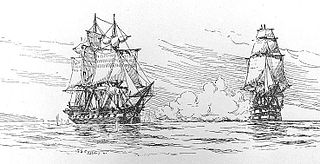 W
WThe Chesapeake–Leopard affair was a naval engagement that occurred off the coast of Norfolk, Virginia, on Monday, June 22, 1807, between the British warship HMS Leopard and the American frigate USS Chesapeake. The crew of Leopard pursued, attacked, and boarded the American frigate, looking for deserters from the Royal Navy. Chesapeake was caught unprepared and after a short battle involving broadsides received from Leopard, the commander of Chesapeake, James Barron, surrendered his vessel to the British. Chesapeake had fired only one shot.
 W
WThe Second Battle of Copenhagen was a British bombardment of the Danish capital, Copenhagen, in order to capture or destroy the Dano-Norwegian fleet, during the Napoleonic Wars. The incident led to the outbreak of the Anglo-Russian War of 1807, which ended with the Treaty of Örebro in 1812.
 W
WCopenhagenization is an expression which coined in the early nineteenth century, and has had seen occasional use since. The expression refers to a decisive blow delivered to a potential opponent while being at peace with that nation. It originated from the Royal Navy's bombardment of Copenhagen in 1807, during the Napoleonic Wars. The term is not recorded in either the Merriam-Webster or the Oxford English dictionaries.
 W
WThe Siege of Danzig was the French encirclement and capture of Danzig during the War of the Fourth Coalition. On 19 March 1807, around 27,000 French troops under Marshall Lefebvre besieged around 14,400 Prussian troops under Marshall Kalckreuth garrisoning the city of Danzig.
 W
WThe naval Battle of the Dardanelles took place on 10–11 May 1807 during the Russo-Turkish War. It was fought between the Russian and Ottoman navies near the Dardanelles Strait.
 W
WThe Dardanelles Operation was the Royal Navy's unsuccessful attempt to impose British demands on the Ottoman Empire as part of the Anglo-Turkish War (1807-1809).
 W
WThe Battle of Eylau or Battle of Preussisch-Eylau, 7 and 8 February 1807, was a bloody and strategically inconclusive battle between Napoleon's Grande Armée and the Imperial Russian Army under the command of Levin August von Bennigsen near the town of Preussisch Eylau in East Prussia. Late in the battle, the Russians received timely reinforcements from a Prussian division of von L'Estocq. After 1945 the town was renamed Bagrationovsk as a part of Kaliningrad Oblast, Russia. The engagement was fought during the War of the Fourth Coalition, part of the Napoleonic Wars.
 W
WThe Fourth Coalition fought against Napoleon's French Empire and were defeated in a war spanning 1806–1807. The main coalition partners were Prussia and Russia with Saxony, Sweden, and Great Britain also contributing. Excluding Prussia, some members of the coalition had previously been fighting France as part of the Third Coalition, and there was no intervening period of general peace. On 9 October 1806, Prussia joined a renewed coalition, fearing the rise in French power after the defeat of Austria and establishment of the French-sponsored Confederation of the Rhine. Prussia and Russia mobilized for a fresh campaign with Prussia massing troops in Saxony.
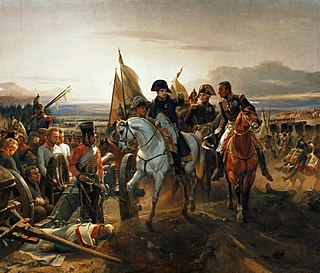 W
WThe Battle of Friedland was a major engagement of the Napoleonic Wars between the armies of the French Empire commanded by Napoleon I and the armies of the Russian Empire led by Count von Bennigsen. Napoleon and the French obtained a decisive victory that routed much of the Russian army, which retreated chaotically over the Alle River by the end of the fighting. The battlefield is located in modern-day Kaliningrad Oblast, near the town of Pravdinsk, Russia.
 W
WThe Froberg mutiny was a mutiny within the British armed forces staged between 4 and 12 April 1807 at Fort Ricasoli, on the island of Malta, then a British Protectorate, by the Froberg Regiment. The regiment had been formed using dubious methods, with personnel recruited from various nationalities in Albania and the Ottoman Empire. The troops, who had arrived on Malta in 1806, were unhappy with their rank and pay. The mutiny lasted for eight days, during which several people were killed and the fort was damaged. The mutiny was put down, and the ringleaders were executed. It is considered the most serious mutiny of the Napoleonic Wars.
 W
WThe Gunboat War was the naval conflict between Denmark–Norway and the British Navy during the Napoleonic Wars. The war's name is derived from the Danish tactic of employing small gunboats against the conventional Royal Navy. In Scandinavia it is seen as the later stage of the English Wars, whose commencement is accounted as the First Battle of Copenhagen in 1801.
 W
WIn the Battle of Guttstadt-Deppen on 5 and 6 June 1807, troops of the Russian Empire led by General Levin August, Count von Bennigsen attacked the First French Empire corps of Marshal Michel Ney. The Russians pressed back their opponents in an action that saw Ney fight a brilliant rearguard action with his heavily outnumbered forces. During the 6th, Ney successfully disengaged his troops and pulled back to the west side of the Pasłęka (Passarge) River. The action occurred during the War of the Fourth Coalition, part of the Napoleonic Wars. Dobre Miasto (Guttstadt) is on Route 51 about 20 kilometers (12 mi) southwest of Lidzbark Warmiński (Heilsberg) and 24 kilometers (15 mi) north of Olsztyn (Allenstein). The fighting occurred along Route 580 which runs southwest from Guttstadt to Kalisty (Deppen) on the Pasłęka.
 W
WThe Battle of Heilsberg took place on 10 June 1807, during the Napoleonic Wars.
 W
WThe Java campaign of 1806–1807 was a minor campaign during the Napoleonic Wars by British Royal Navy forces against a naval squadron of the Kingdom of Holland, a client state of the French Empire, based on the island of Java in the Dutch East Indies. Seeking to eliminate any threat to valuable British merchant convoys passing through the Malacca Straits, Rear-Admiral Sir Edward Pellew determined in early 1806 that the Dutch naval forces based at Java, which included several ships of the line and three frigates, had to be defeated to ensure British dominance in the region. Lacking the forces to effect an invasion of the Dutch colony, Pellew instead sought to isolate and blockade the Dutch squadron based at Batavia in preparation for raids specifically targeting the Dutch ships with his main force.
 W
WThe capture of the Jeune Richard was the result of a naval engagement that took place in the Caribbean on 1 October 1807, during the Napoleonic Wars between the British packet ship Windsor Castle and the French privateer Jeune Richard. In an unequal battle, Windsor Castle, under the command of her acting captain William Rogers, not only defended repeated attacks from the privateer, but finally engaged her, boarded her and after overpowering the much larger crew, forced them below decks, and took the privateer as its prize. The victory was widely reported in contemporary papers and journals, and Rogers and his crew were hailed as heroes and lavishly rewarded for their valour.
 W
WThe Siege of Kolberg took place from March to 2 July 1807 during the War of the Fourth Coalition, part of the Napoleonic Wars. An army of the First French Empire and several foreign auxiliaries of France besieged the Prussian fortified town of Kolberg, the only remaining Prussian-held fortress in the Prussian province of Pomerania. The siege was not successful and was lifted upon the announcement of the peace of Tilsit.
 W
WIn the Battle of Mohrungen on 25 January 1807, most of a First French Empire corps under the leadership of Marshal Jean-Baptiste Bernadotte fought a strong Russian Empire advance guard led by Major General Yevgeni Ivanovich Markov. The French pushed back the main Russian force, but a cavalry raid on the French supply train caused Bernadotte to call off his attacks. After driving off the cavalry, Bernadotte withdrew and the town was occupied by the army of General Levin August, Count von Bennigsen. The fighting took place in and around Morąg in northern Poland, which in 1807 was the East Prussian town of Mohrungen. The action was part of the War of the Fourth Coalition in the Napoleonic Wars.
 W
WThe Battle of Ostrołęka was fought on 16 February 1807 between a First French Empire force under General of Division Anne Jean Marie René Savary and a Russian force under Lieutenant General Ivan Essen. The French defeated the Russians and forced them to retreat to the east to Wyoki Mazowiecki. Weather conditions caused both sides to go into winter quarters immediately after the battle, which occurred during the War of the Fourth Coalition, part of the Napoleonic Wars. Ostrołęka is located in the northeast part of modern Poland, but in 1807 it belonged to the Kingdom of Prussia.
 W
WThe 1807 Ottoman Invasion of Mani was one of a series of invasions by the Ottomans to subdue the Maniots. Mani was the only region of Greece that the Ottomans had not occupied due to the rough terrain and the rebellious spirit of the Maniots. The Maniots caused damage to the Ottomans by allying with the Venetians whenever there was a war between Venice and the Ottomans; they also were pirates.
 W
WThe Peninsular War (1807–1814) was the military conflict fought by Spain and Portugal, assisted by the United Kingdom, against the invading and occupying forces of France for control of the Iberian Peninsula during the Napoleonic Wars. In Spain, it is considered to overlap with the Spanish War of Independence. The war began when the French and Spanish armies invaded and occupied Portugal in 1807 by transiting through Spain, and it escalated in 1808 after Napoleonic France had occupied Spain, which had been its ally. Napoleon Bonaparte forced the abdications of Ferdinand VII and his father Charles IV and then installed his brother Joseph Bonaparte on the Spanish throne and promulgated the Bayonne Constitution. Most Iberians rejected French rule and fought a bloody war to oust them. The war on the peninsula lasted until the Sixth Coalition defeated Napoleon in 1814, and it is regarded as one of the first wars of national liberation and is significant for the emergence of large-scale guerrilla warfare.
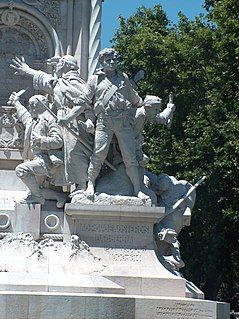 W
WThe Invasion of Portugal saw an Imperial French corps under Jean-Andoche Junot and Spanish military troops invade the Kingdom of Portugal, which was headed by its Prince Regent João of Bragança. The military operation resulted in the almost bloodless occupation of Portugal. The French and Spanish presence was challenged by the Portuguese people and by the United Kingdom in 1808. The invasion marked the start of the Peninsular War, part of the Napoleonic Wars.
 W
WThe Raid on Samaná was a land and naval action where two Royal Navy ships attacked the French held port of Samaná in Santo Domingo on 14 February 1807 during the Napoleonic wars. They captured and burned a fort and then captured a number of ships which included two prizes with only light losses.
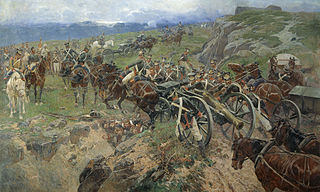 W
WThe 1804–1813 Russo-Persian War was one of the many wars between the Persian Empire and Imperial Russia, and began like many of their wars as a territorial dispute. The new Persian king, Fath Ali Shah Qajar, wanted to consolidate the northernmost reaches of his kingdom—modern-day Georgia—which had been annexed by Tsar Paul I several years after the Russo-Persian War of 1796. Like his Persian counterpart, the Tsar Alexander I was also new to the throne and equally determined to control the disputed territories.
 W
WThe Russo-Turkish War (1806–1812) between the Russian Empire and the Ottoman Empire was one of the Russo-Turkish Wars. Russia prevailed, but both sides wanted peace as they feared Napoleon's moves to the east.
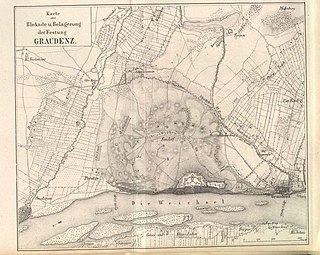 W
WThe Siege of Graudenz was a siege during the Napoleonic Wars between 22 January and 11 December, 1807. As part of the War of the Fourth Coalition the Prussian fortress at Graudenz in West Prussia was besieged by forces of the French Empire and its allies. The garrison, commanded by General Wilhelm René de l'Homme de Courbière, withheld blockade and siege for some 11 months, long past the formal Peace of Tilsit. The French abandoned the siege after the borders between Prussia and the new Duchy of Warsaw were defined; Graudenz staying a Prussian possession until after World War I.
 W
WThe Great Sortie of Stralsund was fought in the Franco-Swedish War on 1–3 April 1807, in Swedish Pomerania. A French army under Édouard Mortier invaded Swedish Pomerania in early 1807 and initiated a blockade of the Swedish town of Stralsund, to secure the French rear from enemy attacks. After several smaller sorties and skirmishes around Stralsund, Mortier marched part of his army to support the ongoing Siege of Kolberg, leaving only a smaller force under Charles Louis Dieudonné Grandjean to keep the Swedes at check. The Swedish commander Hans Henric von Essen then commenced a great sortie to push the remaining French forces out of Swedish Pomerania. The French fought bravely on 1 April at Lüssow, Lüdershagen and Voigdehagen, but were eventually forced to withdraw; the Swedes captured Greifswald the next day, after a brief confrontation. The last day of fighting occurred at Demmin and Anklam, where the Swedes took many French prisoners of war, resulting in the complete French withdrawal out of Swedish Pomerania—while the Swedes continued their offensive into Prussia. After two weeks Mortier returned and pushed the Swedish forces back into Swedish Pomerania. After an armistice the French forces once again invaded, on 13 July, and laid siege to Stralsund, which they captured on 20 August; all of Swedish Pomerania was captured by 7 September, but the war between Sweden and France continued until January 6, 1810, when the Swedes were finally forced to sign the Treaty of Paris.
 W
WThe Siege of Stralsund lasted from 24 July to 24 August 1807 and saw troops from the First French Empire twice attempt to capture the port city from Lieutenant General Hans Henric von Essen's 15,000-man Swedish garrison. Early in the year, Marshal Édouard Adolphe Casimir Joseph Mortier blockaded the city for two months before he was called elsewhere. In his absence, the Swedes drove back the inferior blockading force. After Mortier returned and pushed Essen's troops back in turn, the two sides quickly concluded an armistice. The truce was later repudiated by King Gustav IV Adolf of Sweden, whereupon Marshal Guillaume Marie Anne Brune led 40,000 French, German, Spanish, Italian, and Dutch soldiers against the fortress. Fearfully outnumbered, the Swedes abandoned the Baltic Sea port of Stralsund to the Franco-Allies in this action during the War of the Fourth Coalition, part of the Napoleonic Wars. As a consequence, Sweden also lost the nearby island of Rügen.
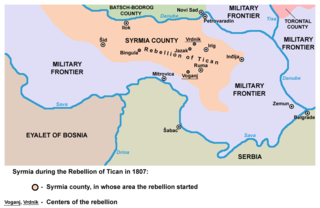 W
WThe Tican's rebellion was a rebellion of the Syrmian peasants against feudal relations in society. The rebellion started in April 1807 on the estate of Ruma of earl Karlo Pejačević and estate of Ilok of earl Odescalchi. The reason for the rebellion was large increase of feudal tributes and dissatisfaction because of land regulation.
 W
WThe Battle of Zealand Point was a naval battle of the English Wars and the Gunboat War. Ships of the Danish and British navies fought off Zealand Point on 22 March 1808; the battle was a British victory.